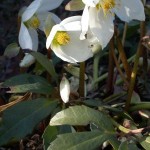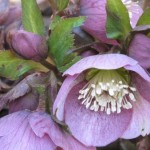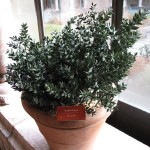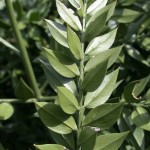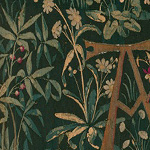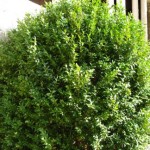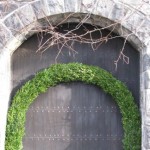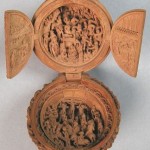Archive for the ‘Useful Plants’ Category
Friday, September 7, 2012
Crithmon, some call it Critamon, is a little shrubbie herbe, thick of leaves, the height of it is about a cubit, growing in rockie and maritime places, being full of fatt, and whitish leaves, like unto those of Purcelane, yet thicker & longer & salt to ye tast.
???Dioscorides, De Materia Medica, Book II: 157
Rock samphire is one of several maritime species grown in Bonnefont herb garden. This edible plant was foraged rather than cultivated in the Middle Ages; it also had medicinal uses. Below, left to right: Samphire in bloom; the flower structure is typical of the Apiaceae, a large family of??aromatic plants. Ripening seedheads; the name “crithmon” by which the plant was known in antiquity is thought to derive from the Greek word for barley, as the seeds resemble the grain.
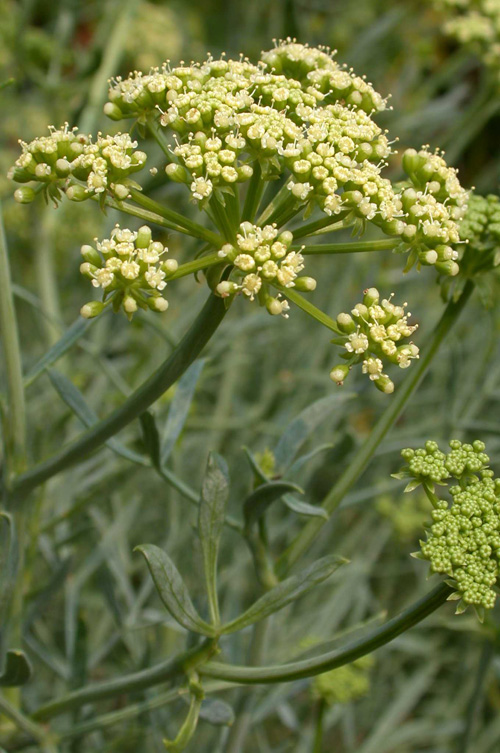
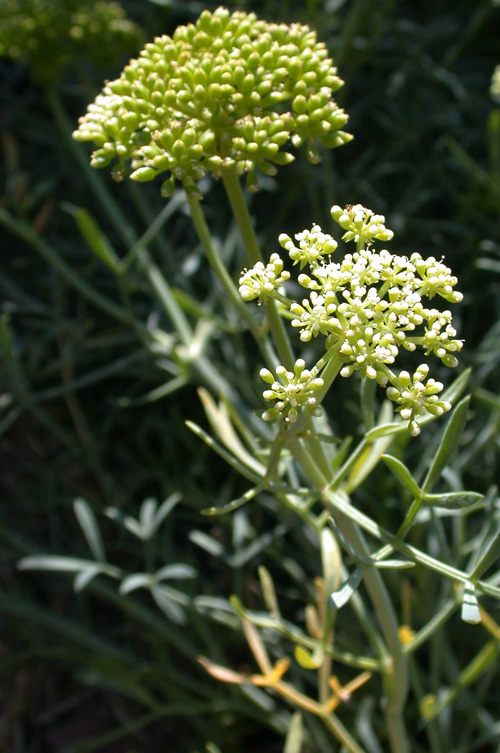
Read more »
Tags: Apiaceae, Crithmum maritimum, Dioscorides, glasswort, John Gerard, King Lear, Pliny the Elder, rock samphire, Salicornia europea, sampier
Posted in Gardening at The Cloisters, Medicinal Plants, Useful Plants | Comments (0)
Monday, July 16, 2012


The courtyard, as seen from the portcullis gate entrance in 1938, at left, and in 2012, at right. Photograph on right by Andrew Winslow
Visitors to The Cloisters may have spied the top of a large oak tree just above the wall at the postern gate entrance. This white oak grows in a courtyard enclosed by the ramparts, which also include maintenance passages, storage, an education workshop area, and garden workspaces.
Read more »
Tags: acorn, oak, Quercus, tree
Posted in Botany for Gardeners, Gardening at The Cloisters, Useful Plants | Comments (3)
Friday, May 25, 2012
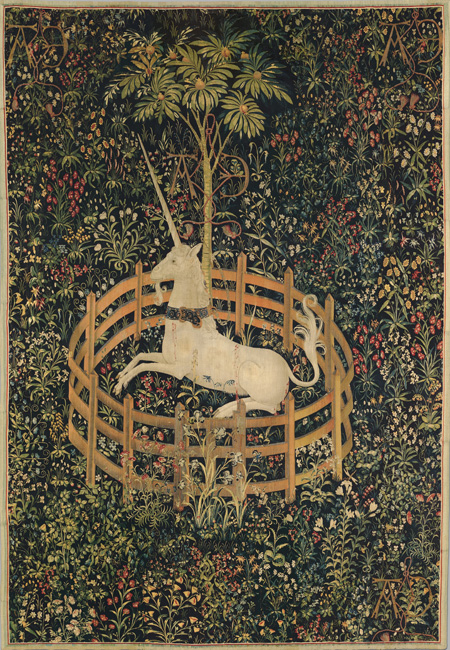
The Unicorn in Captivity, 1495???1505. The Metropolitan Museum of Art, New York, Gift of John D. Rockefeller Jr., 1937 (37.80.6). The profusion of flowering plants that springs from the millefleurs meadow on which the unicorn rests includes both garden plants and wildflowers. An iris and a clove pink are prominently placed outside the unicorn’s enclosure; both were intensively cultivated in the Middle Ages, but the purple orchis silhouetted against the unicorn’s body depends on a special relationship with microorganisms in its native soil and would not have grown in gardens.
Roses, lilies, iris, violet, fennel, sage, rosemary, and many other aromatic herbs and flowers were prized for their beauty and fragrance, as well as their culinary and medicinal value, and were as much at home in the medieval pleasure garden as in the kitchen or physic garden. These plants were carefully cultivated, but many useful plants of the Middle Ages were found outside the garden walls, or admitted on sufferance.
Read more »
Tags: colewort, Fennel, gourd, herb, Hortulus, iris, kale, lamb's quarters, lettuce, lily, melon, nettle, poppy, pulse, purslane, rose, rosemary, sage, violet, Walahfrid Strabo
Posted in Food and Beverage Plants, Fragrant Plants, Medicinal Plants, Plants in Medieval Art, Useful Plants | Comments (1)
Friday, February 3, 2012
The trees went to anoint a king over them: and they said to the olive tree: Reign thou over us
And it answered: Can I leave my fatness, which both gods and men make use of, to come to be promoted among the trees?
???Judges 9: 8-9, Douay-Rheims Bible
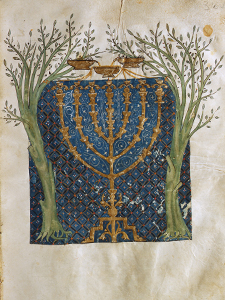
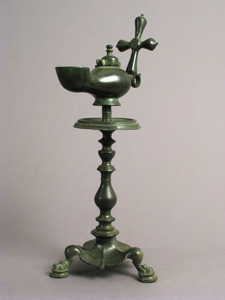
Olive oil provided fuel for sanctuary lamps throughout the Mediterranean world in antiquity and the Middle Ages, as well as holy oils for religious purposes. Above, left: A menorah flanked by two olive trees, as depicted in the Cervera Bible, recently on view at the Main Building. The brimming vessels?? used to fill the lamp appear at the top of the menorah. Right: A fifth-century standing lamp decorated with a cross; bronze lamps of this type were common in the early Byzantine world.
The olive was held to be the first of trees in both classical and biblical antiquity, prized above even the grapevine and the fig. A gift of the goddess Athena, the sacred olive symbolized the arts of peace and prosperity; the ruthless destruction of an enemy’s olive groves in wartime was held to be sacrilegious act. The Roman natural historian Pliny, writing in the first century A.D., attests that Athena’s olive was still venerated on the Athenian acropolis in his day (Historia naturalis, XVI 239???40). Although slow to bear, the tree is very long lived, surviving for hundreds of years. (The SpiceLines blog features an illustrated post about a Spanish olive estimated to be eighteen hundred years old.)
Read more »
Tags: chrism, drupe, glucoside, Hildegard of Bingen, Mediterranean, oil, oleaster, olive, Physica, Pliny, Tacuinum Sanitatis
Posted in Food and Beverage Plants, Medicinal Plants, Plants in Medieval Art, Useful Plants | Comments (0)
Friday, January 27, 2012

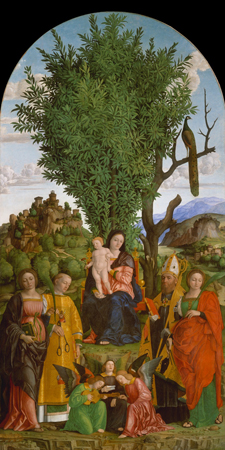
The evergreen bay laurel (Laurus nobilis), a symbol of victory and eternal life, is not as tender as some other Mediterranean species, but it must be grown in pots and wintered over indoors at The Cloisters. Above, left: Bay laurel topiaries like this one spend the winter in the glassed-in arcades of Cuxa cloister and return to Bonnefont herb garden in May. Right: The magnificent bay tree that flourishes at the center of Girolamo dai Libri’s Madonna and Child with Saints represents Resurrection, and is juxtaposed with the naked limbs of a dead tree.
The laurel itself is a bringer of peace, inasmuch as to hold a branch of it out even between enemy armies is a token of cessation of hostilities. With the Romans especially it is used as a harbinger of rejoicing and of victory, accompanying despatches and decorating the spears and javelins of the soldiery and adorning the generals??? rods of office. From this tree a branch is deposited in the lap of Jupiter the All-good and All-great whenever a fresh victory has brought rejoicing, and this is not because the laurel is continually green, nor yet because it is an emblem of peace, as the olive is to be preferred in both respects, but because it flourishes in the greatest beauty on Mount Parnassus, and consequently is thought to be also dear to Apollo, to whose shrine even the kings of Rome at that early date were in the custom of sending gifts and asking for oracles in return.
???Pliny, Historia Naturalis, Book XV, 133
Read more »
Tags: Apollo, bay, cinnamon, Daphne, Dioscorides, evergreen, Girolamo dai Libri, Hildegard of Bingen, Jashemski, laurel, Laurus nobilis, Ovid, Pliny, Pompeii
Posted in Gardening at The Cloisters, Medicinal Plants, Plants in Medieval Art, Useful Plants | Comments (1)
Friday, October 21, 2011

A tub of rose hips, gathered from roadsides and abandoned pastures upstate, and stripped of their thorns. The hips will be used to decorate the Museum this winter. Photograph by Carly Still
The rose hips used in the winter holiday decorations at The Cloisters allude to the rose symbolism prevalent in medieval Christmas carols. Although we grow medieval rose species in the gardens and on the grounds, their hips are too fleshy for our purposes, and don’t keep well.?? We gather stems of Rosa multiflora, which bear many small, hard, hips, in October, and strip them??of their thorns. They are stored in a cool, dry place until December, when the Museum is decked for the season.
Read more »
Tags: cattle, erosion, hips, Japanese rose, Rosa multiflora, rose, rose hip, weed
Posted in Food and Beverage Plants, Gardening at The Cloisters, Medicinal Plants, Useful Plants | Comments (1)
Saturday, February 5, 2011


Above: Two details from a tapestry-woven praetexta (Germany, Cologne, about 1450-75) currently on display at The Cloisters. The??flower shown at the center??of the detail on the??left is a fantasy.??The detail on the??right??shows a botanically unmistakable lily;?? a strawberry, embellished with a fanciful??and botanically incorrect??element at the??bottom of the fruit,??appears just below and to the left of the lily.?? See the full image.
A plant in a medieval work of art need not be naturalistically depicted to be recognizable. Even a very stylized representation may have characteristics so distinctive that it can be given a botanical identity with complete confidence. Read more »
Tags: achene, berry, Fragaria vesca, hull, lily, Narcissus pseudo-narcissus, seeds, strawberry
Posted in Plants in Medieval Art, Useful Plants | Comments (0)
Wednesday, March 24, 2010
Above, from left to right: Detail of stinking hellebore, Helleborus foetidus, the first to bloom of the three hellebore species grown in Bonnefont garden; detail of the Christmas rose, Helleborus niger, in blossom; detail of the flowers of the Lenten rose, Helleborus orientalis.
The name “hellebore” does not derive from the Anglo-Saxon word “hell,” although hellebore might well be described as hellish in some of its actions and associations. Some older sources derive the generic name of the plant from the Greek elein (to injure) and bora (food), indicating its poisonous nature. However etymologists now conjecture that hellebore is derived from ellos???a young deer???and bora, meaning “the food of fawns”. I’ve asked Alain Touwaide, a classical scholar and an authority on ancient medicinal herbs,??whose work on an important medieval medical text is featured on the Science at the Smithsonian website, to comment on this derivation.
The magico-medicinal character of hellebore, a poisonous member of the Ranunculaceae, a botanical family which includes other deadly species such as aconite, was established in Greek antiquity. Read more »
Tags: hellebore, Helleborus foetidus, Helleborus niger, Helleborus orientalis
Posted in Magical Plants, Medicinal Plants, Useful Plants | Comments (10)
Friday, January 22, 2010
Above, from left: Butcher???s broom growing in a pot indoors in Cuxa Cloister; detail of the stiff, sharp “leaves,” which are actually modified stems; detail from the tapestry The Hunters Enter the Woods showing Butcher’s broom.
An odd-looking little shrub, Butcher???s broom (Ruscus aculeatus), which reaches a height between one and a half and two feet for us here at The Cloisters, was also known as knee-holly, because of its short stature and prickly nature. (Another old name is “pettygree” or “pettygrew.”) Usually included in the very large lily family, butcher???s broom is a botanical curiosity as well as a household and medicinal plant with a long history of use. Read more »
Tags: asparagus, butcher's_broom, lily, Ruscus_aculeatus
Posted in Gardening at The Cloisters, Medicinal Plants, Useful Plants | Comments (0)
Friday, December 18, 2009
Above, from left to right: Boxwood shrub growing in Bonnefont Garden; fresh boxwood installed on the Main Hall arches for the holidays; detail view of a minutely carved boxwood rosary bead in The Cloisters collection. See the Collection Database to learn more about this work of art.
Boxwood (Buxus sempervirens) is most familiar to us as a foundation planting, or as a low edging for garden beds, a practice that became common in the sixteenth century and continues today. Boxwood has also been a popular subject for topiary work since Roman times. There are many varieties of box, including dwarf forms and forms with variegated foliage. (For more about B. sempervirens and other ornamental species, visit the website of The American Boxwood Society.) Read more »
Tags: boxwood, Buxus sempervirens, yew
Posted in Fragrant Plants, Medicinal Plants, Useful Plants | Comments (2)














